Get the week's most popular posts delivered to your inbox.
Our weekly update is free yet priceless and you're less than a minute away from getting the current edition.
In the unlikely event we disappoint, you can unsubscribe with a single click!
Last Updated on August 12, 2024 by teamobn
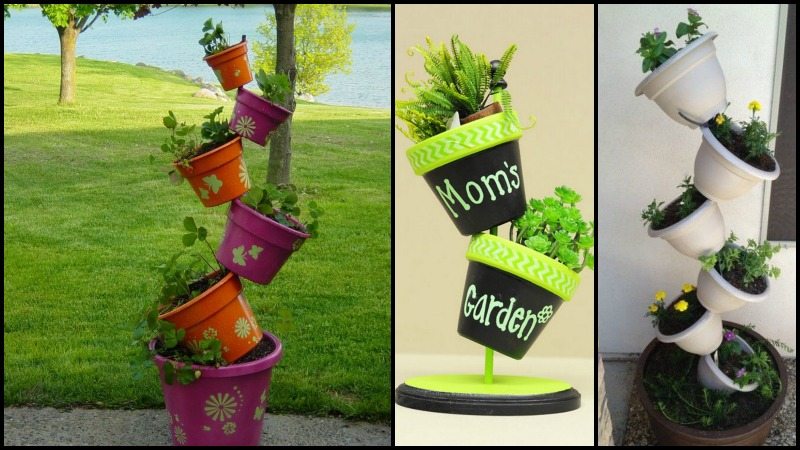
Short on space for a garden? Then this gardening DIY Topsy Turvy Herb Garden project is for you!
For people who are not very green-thumbed, a Topsy Turvy is a gardening tool that makes it easier to grow herbs indoors. This self-watering system allows you to grow plants in containers, not on the ground.
The Topsy Turvy is a self-watering, upside-down, or stacked planter that allows you to grow your herbs and plants not only outdoors but also indoors, all year-round.
The Topsy Turvy consists of a plastic reservoir that fits into the pot with a built-in watering system, and a tray or a rod that holds the soil and plants. In short, topsy turvy planters are vertical planters.
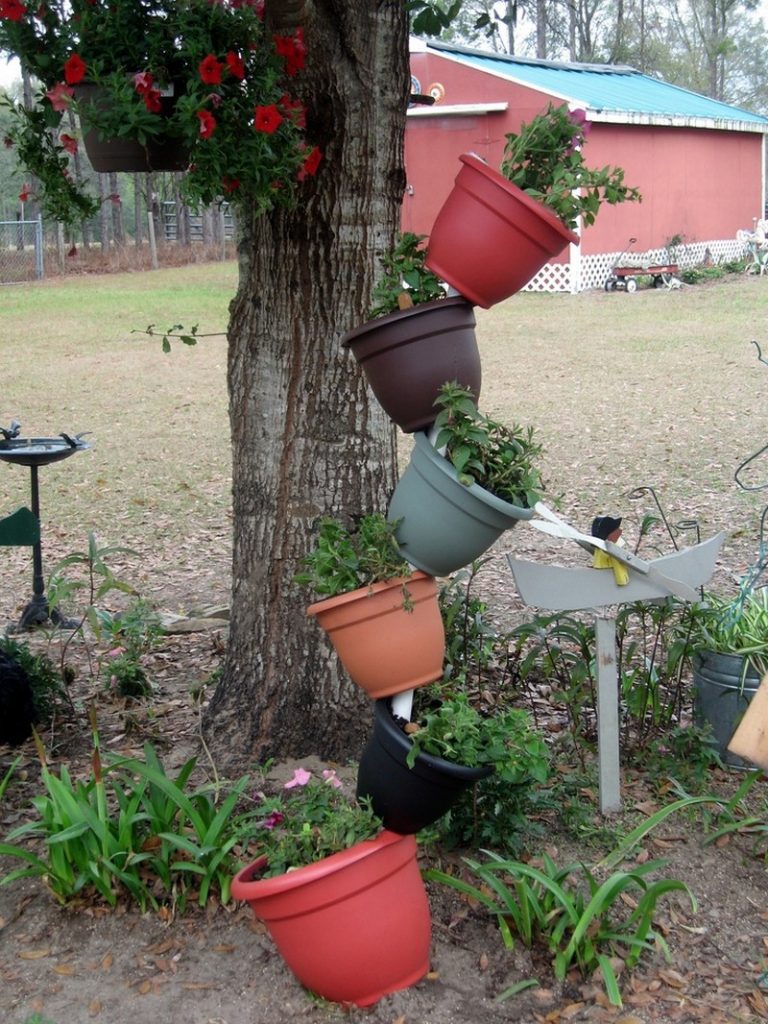
Going vertical is an economical use of space. Topsy turvy planters make your garden even more interesting by the way your pots look. It is a herb garden that grows upward (in addition to sideways).
It is a smaller version of their larger container herb garden. The Topsy Turvy Herb Garden is ideal for growing mint, parsley, and other herbs that do not need a large amount of space.
A Topsy Turvy Herb Garden is a vertical herb garden that stands on its own. It has several advantages over a traditional garden, including that it has a small footprint, it is easy to maintain.
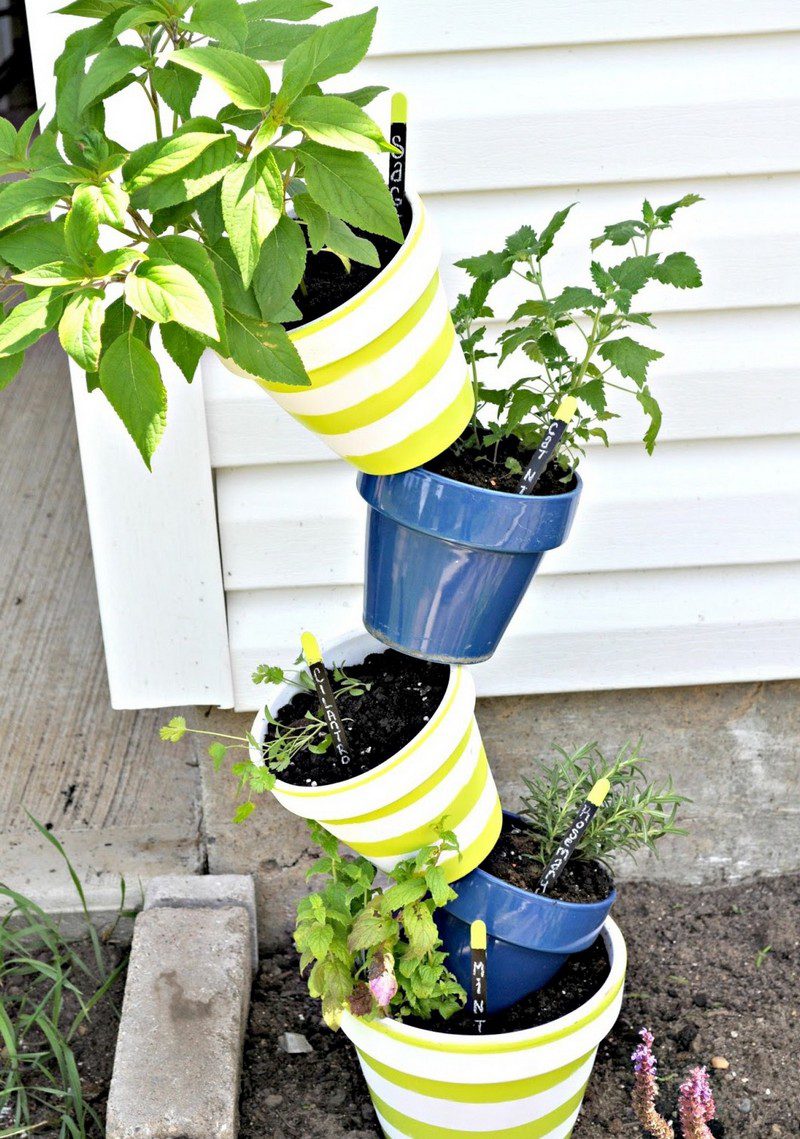
It doesn’t require staking, you can grow many more kinds of herbs in it, and you can grow herbs in places where you can’t grow a traditional garden, and it is much prettier than a traditional garden.
By growing herbs in an upright position, you are able to grow a greater amount of herbs in a smaller area because they are growing toward the light.
Using only steel rebar or a wooden rod, and a couple of terra cotta pots, you can have your vertical garden.
The materials you need to finish this project might be found in your garden already. If you don’t have them yet, you can be assured that they’re inexpensive and easily found in your local gardening store.
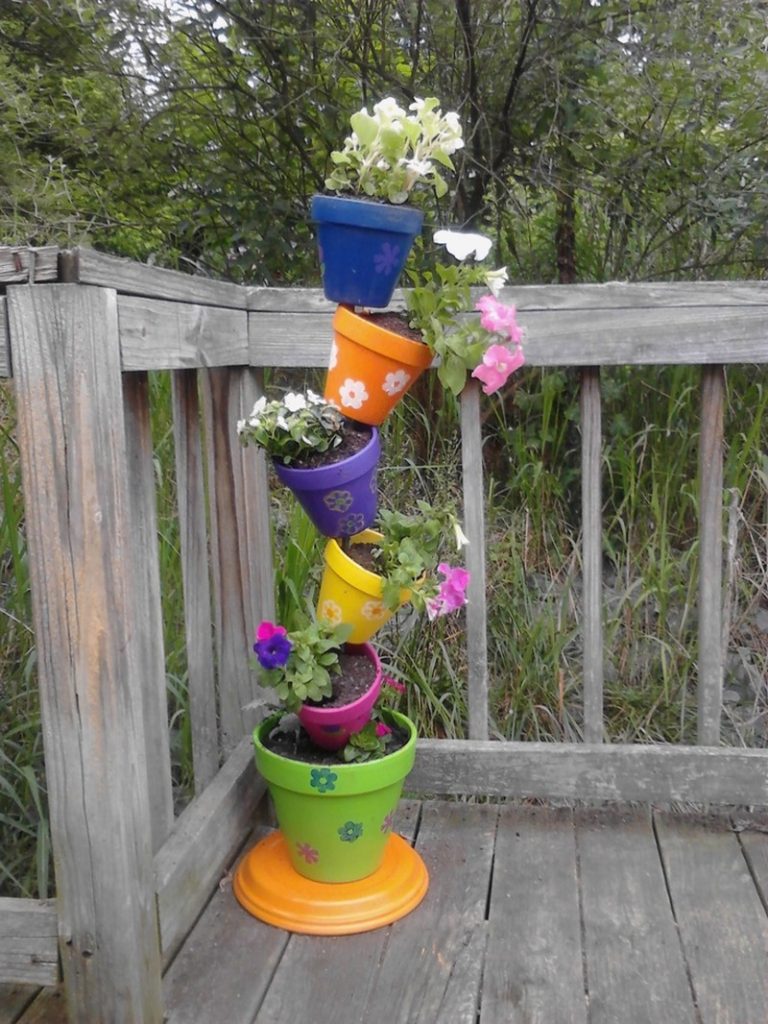
Are you ready to start your vertical garden?
Making a Topsy Turby Herb Garden
Materials
- 4 pcs – 6″ Tall Terra Cotta Pots
- 1 pc – 8″ Tall Terra Cotta Pot (for base)
- 1 pc – 3/8in x 4ft #3 Steel Rebar Pin
- Spray Paint & Primer (optional)
- Herbs/Flowers
- Steel rebar or wooden rod
Tools
- Rubber Mallet
- Trowel
Click on any image to start the lightbox display. Use your Esc key to close the lightbox. You can also view the images as a slideshow if you prefer 😎
Instructions
Step 1: Prepare the Base
- Start by taking the 8″ tall terra cotta pot, which will serve as the stable base of your herb garden.
- Position the steel rebar pin or wooden rod in the center of the pot. Ensure it’s standing upright.
- Use a rubber mallet to gently but firmly tap the rod into the soil or base material you’ve placed in the pot to help it stay upright and secure.
Step 2: Paint the Pots (Optional)
Allow the paint to dry completely as per the instructions on the paint can.
Before assembling, consider personalizing your pots. Spray paint the terra cotta pots with your chosen colors. Apply a primer first to ensure better adhesion of the paint.
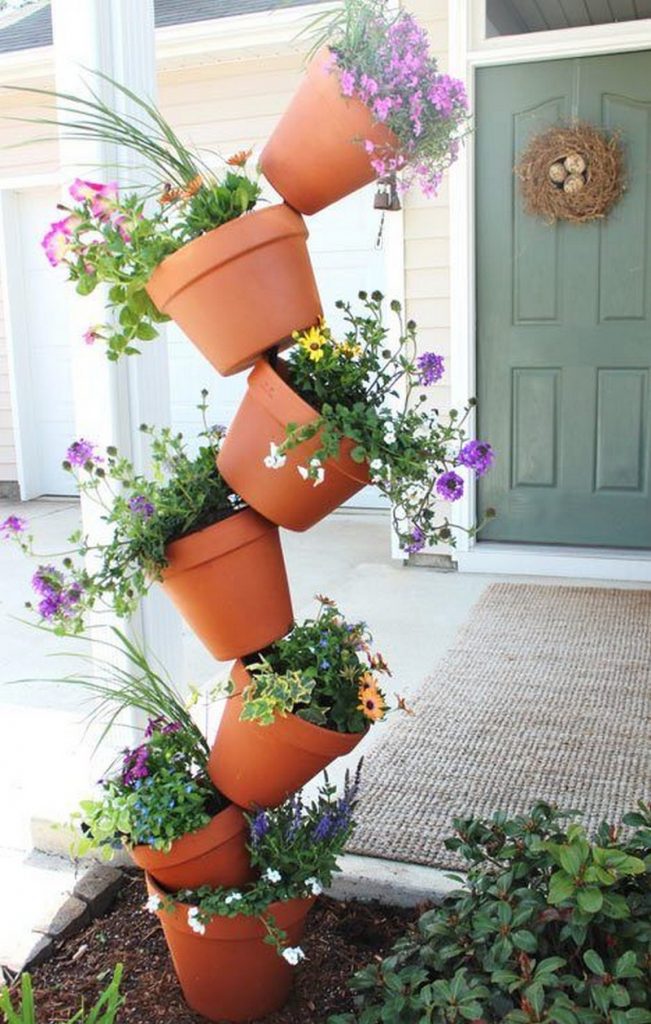
Step 3: Stack the Pots
- Begin stacking the 6″ tall terra cotta pots. Slide the first pot through the steel rebar or rod, letting it rest on the base pot.
- Tilt each pot slightly in alternating directions as you stack them. This staggered arrangement allows plants to receive ample sunlight and creates the topsy turvy effect.
- Use the trowel to add or adjust the positioning soil inside each pot if necessary to achieve the desired angle.
Step 4: Secure the Structure
- Continue adding the remaining pots, ensuring each is securely angled before adding the next.
- The final top pot should be stable and secure. Check each pot by gently nudging to ensure they are firmly in place and won’t shift.
Step 5: Planting
- Gently pack the soil around each plant to ensure it is firmly planted and well supported.
- Mix soil with a suitable fertilizer and fill each pot with the soil mixture using your trowel.
- Plant your chosen herbs or flowers in each pot. Make sure to consider the growth requirements and space needs of each herb or flower.
Step 6: Watering
- Thoroughly water your newly planted herbs or flowers, ensuring the water penetrates the soil in each pot.
- The design of your topsy turvy garden should allow excess water to trickle down from the upper pots to the lower ones, making watering more efficient.
Step 7: Final Placement
- Choose a sunny spot for your topsy turvy herb garden. Since it is not fixed to the ground, you can move it around to ensure it gets enough sunlight throughout the day.
- Regularly check the soil moisture and water as needed. The unique stacking can affect how quickly the soil dries out.
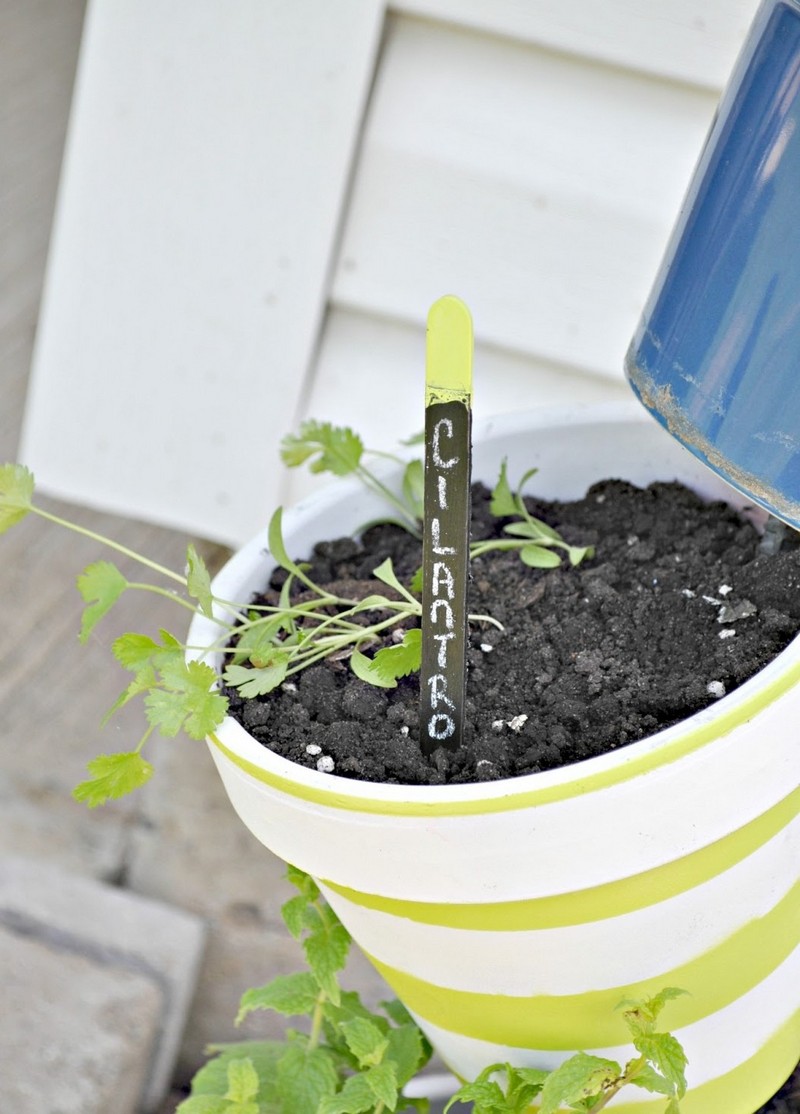

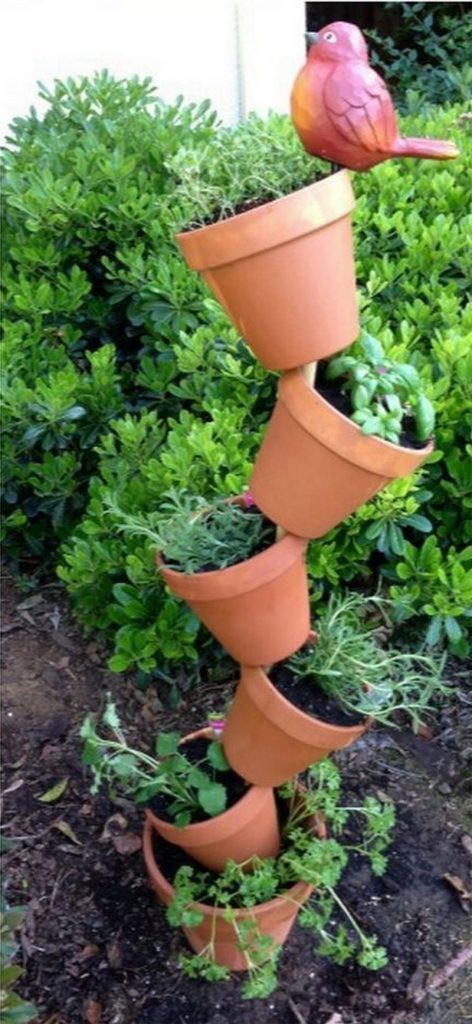


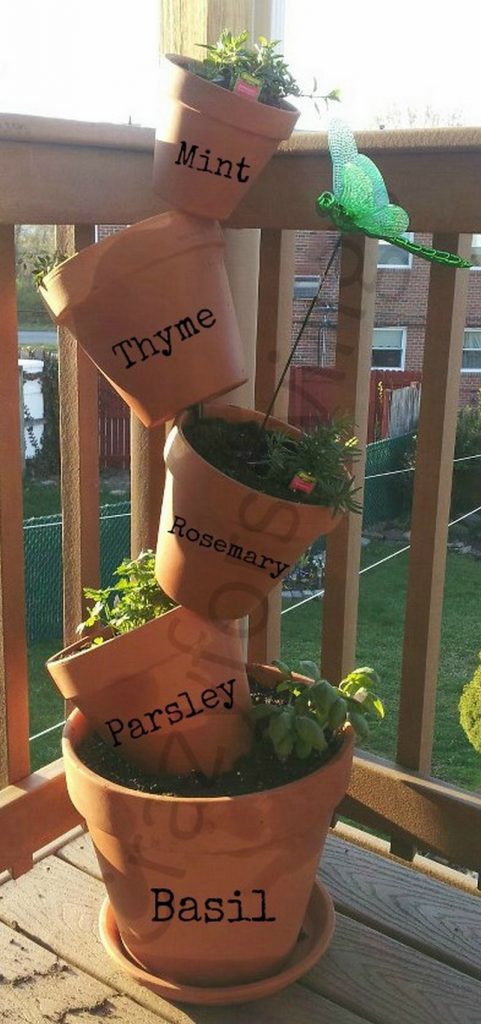
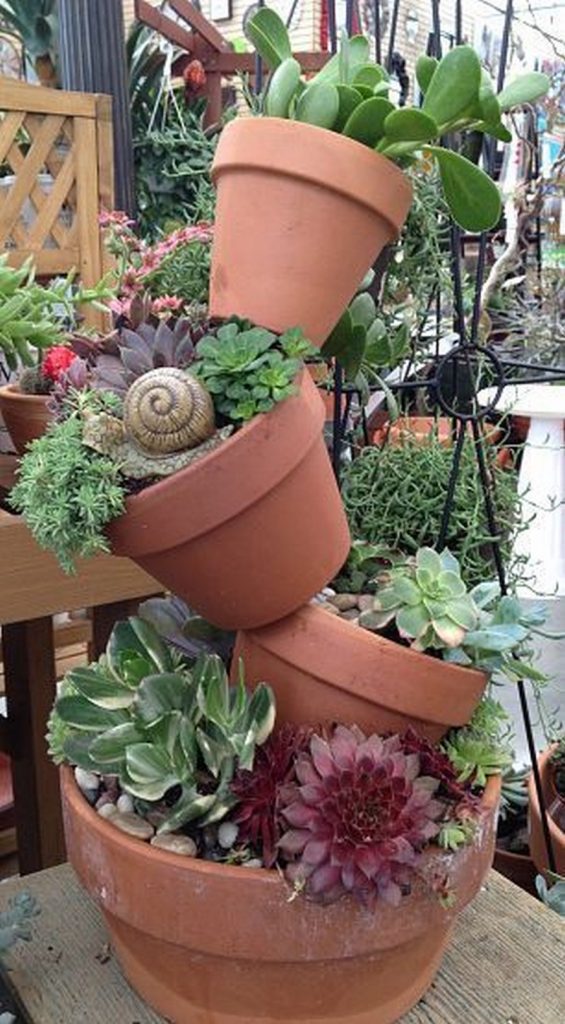
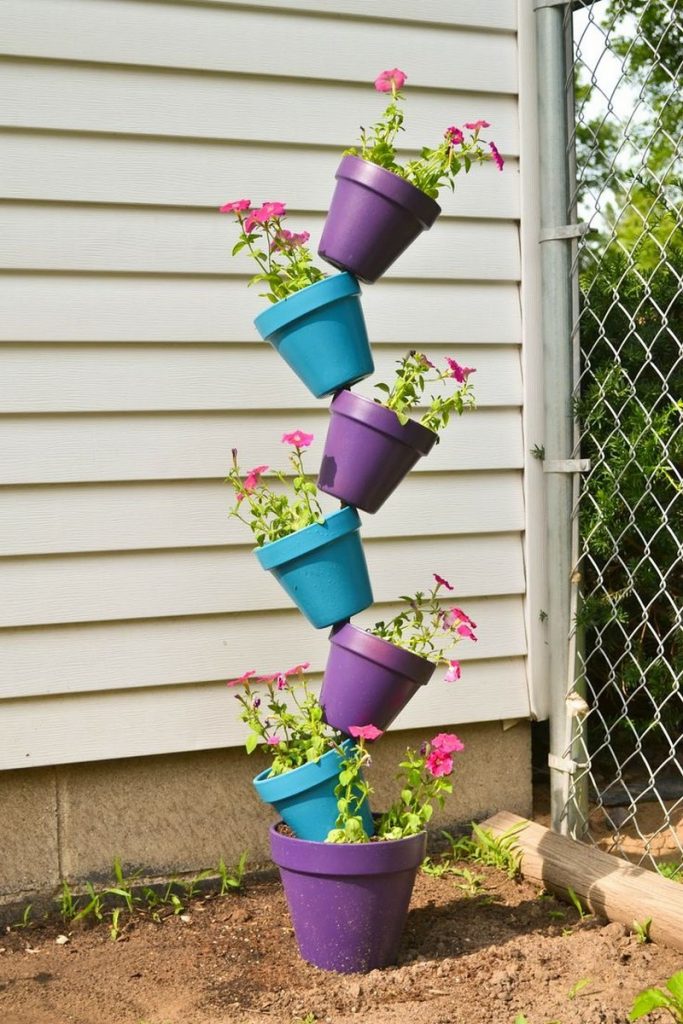
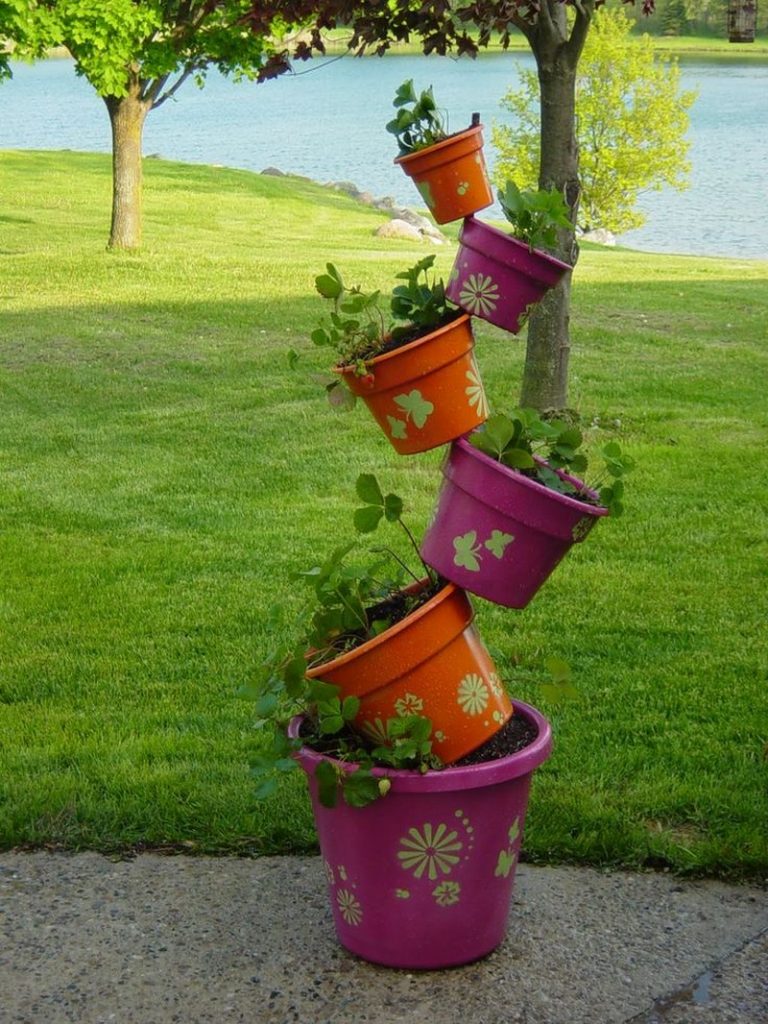
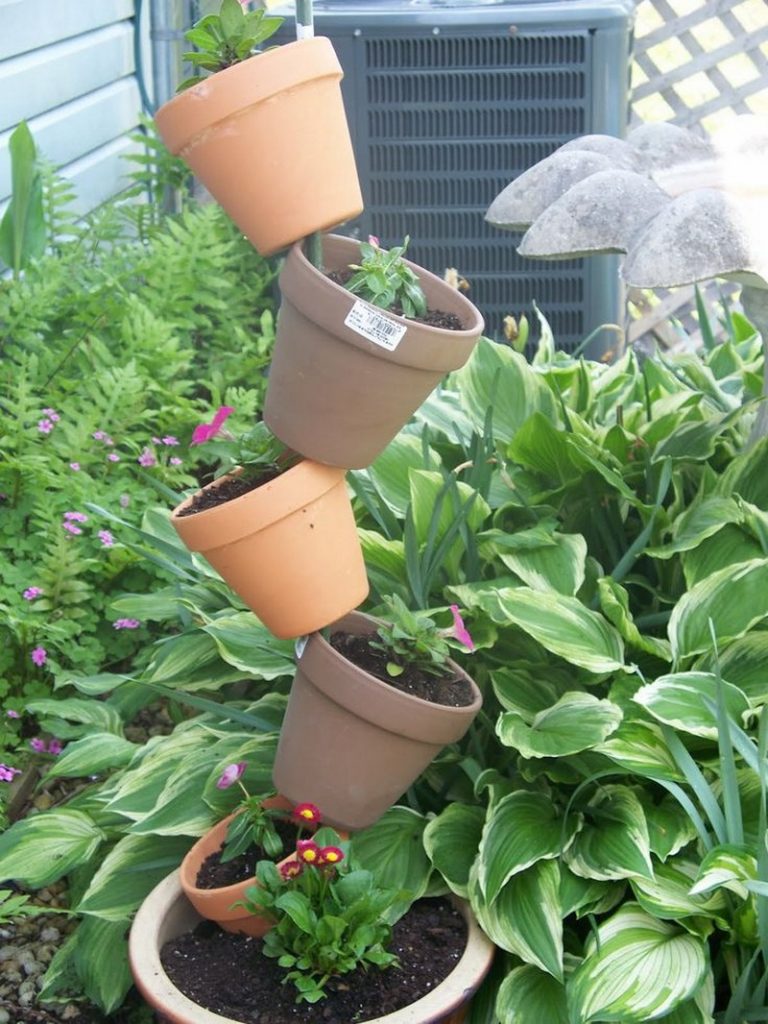
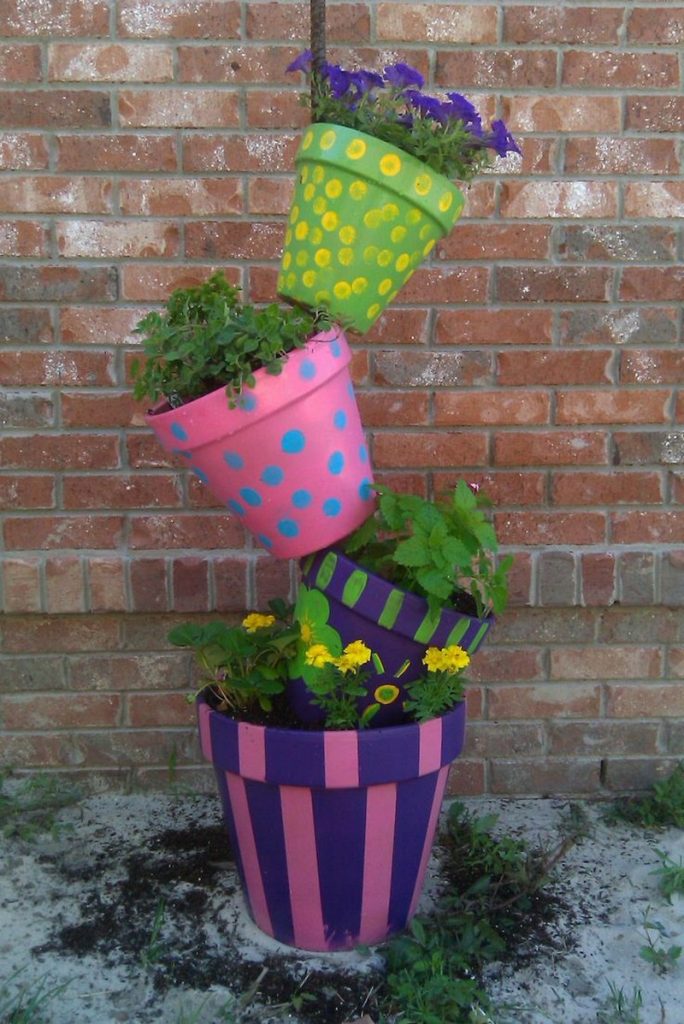
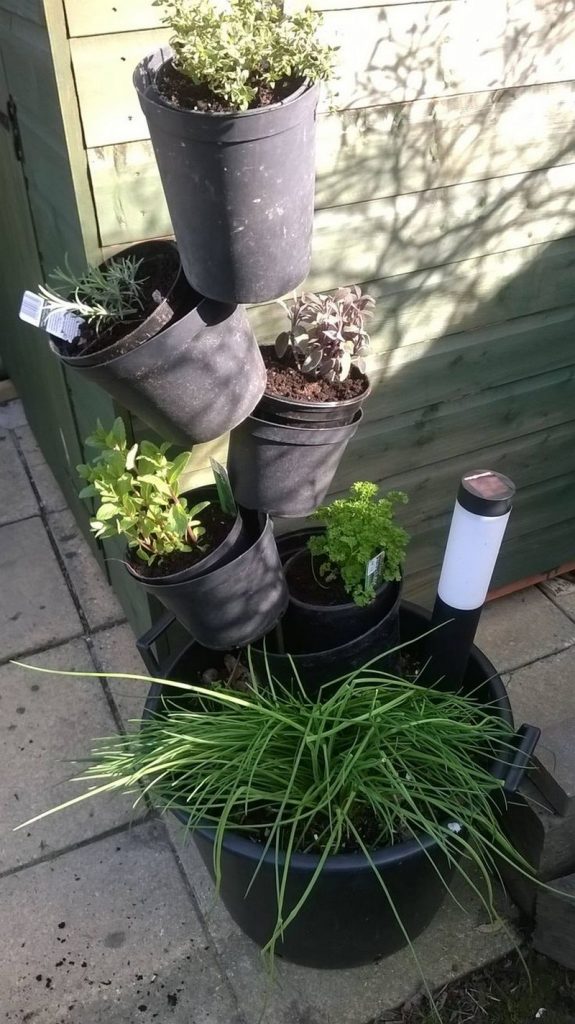
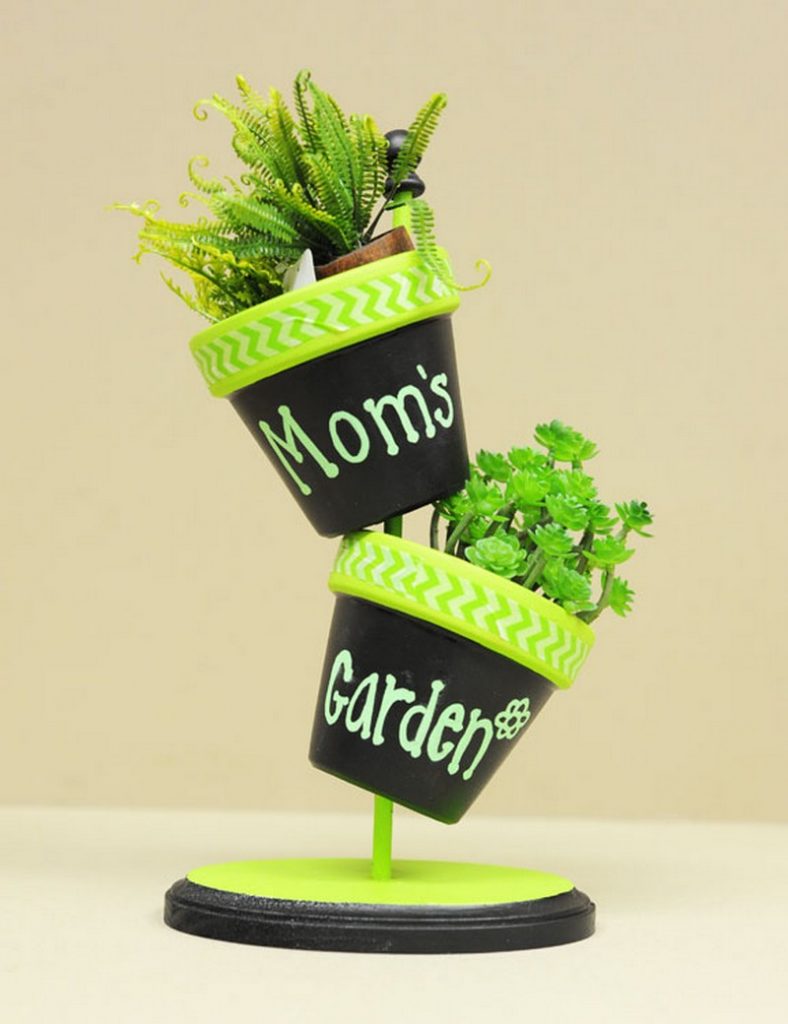
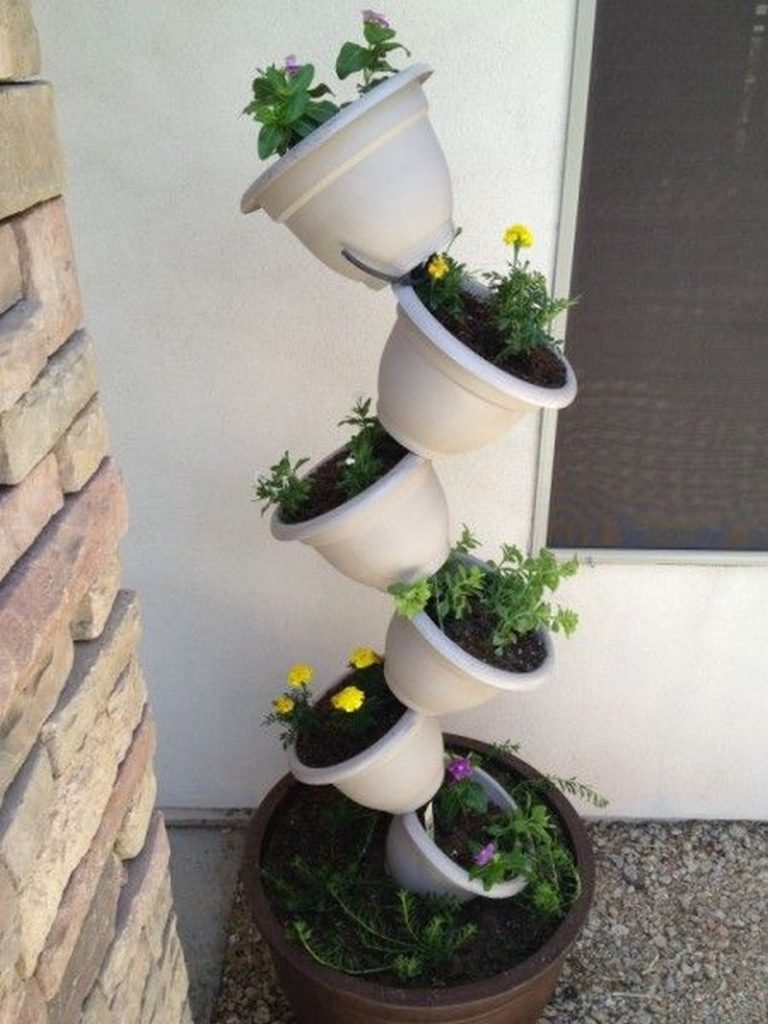

Thanks to Keep Calm and Decorate for this great project. You can get step-by-step instructions here…
Optimal Herb Selection for Topsy Turvy Gardens
Choosing the right herbs for your topsy turvy herb garden is essential to ensure healthy growth and abundant harvests. Topsy turvy gardens offer a unique vertical planting solution that can maximize your gardening space, especially if you’re limited by the confines of an apartment balcony or a small backyard.
Here’s a guide to selecting the best herbs that thrive in the distinctive environment of a topsy turvy herb garden.
Hardy Herbs for Topsy Turvy Gardens
Herbs that are resilient and can adapt to the vertical growing conditions of a topsy turvy herb garden are ideal. Consider planting herbs like:
- Mint: Known for its vigorous growth, mint is perfect for the topsy turvy herb garden as it can easily adapt to the vertical space and requires minimal care beyond regular watering.
- Thyme: This drought-resistant herb thrives in well-drained soil and can handle the occasionally dry conditions of a topsy turvy planter.
- Oregano: Hardy and versatile, oregano grows well in a topsy turvy herb garden, providing a rich flavor to various dishes.
Herbs with Shallow Roots for Topsy Turvy Gardens
Herbs with shallow root systems are particularly well-suited for the confined spaces of a topsy turvy herb garden. These include:
- Basil: With its compact root system, basil is ideal for topsy turvy gardens. It requires plenty of sunlight and regular watering, making it a perfect candidate for the upper levels of the garden.
- Parsley: This herb prefers a cooler environment, which can be managed by positioning the topsy turvy garden in a partially shaded area during the hottest parts of the day.
- Cilantro: Known for its fast growth cycle, cilantro works well in the unique setup of a topsy turvy garden, especially if harvested regularly to promote fresh growth.
Aromatic Herbs for Topsy Turvy Gardens
Not only do aromatic herbs enhance the taste of food, but they also scent your garden. Perfect choices for a topsy turvy herb garden consist in:
- Lavender: Although lavender is usually known for its flowers, its aromatic leaves are fantastic for both ornamental and cooking. It prefers well-drained, full sun soil.
- Rosemary: Rosemary is easy to maintain since it loves the vertical aspect of topsy turvy gardens and requires less regular watering.
- Chives: Chives are great in a topsy turvy garden because of their subtle onion taste. They thrive in cooler temperatures and demand little space.
While each of these herbs improves the visual appeal of your topsy turvy herb garden, they also provide different tastes and advantages for your cuisine. Choosing the correct herbs guarantees that your garden not only serves as a beautiful accent to your house but also is efficient.
DIY Customizations and Decorations
Personalizing your topsy turvy herb garden not only enhances its aesthetic appeal but also allows it to better reflect your personal style and fit seamlessly into your home or garden decor. Here are some creative DIY customization and decoration ideas to make your topsy turvy herb garden uniquely yours.
Paint and Color Schemes
Adding color to your topsy turvy herb garden is one of the easiest ways to make it stand out. Use weather-resistant paints to add vibrant colors or patterns to the pots. Choose a color scheme that complements the exterior of your home or the dominant colors in your garden. This can turn your herb garden into a focal point on your patio or balcony.
Decorative Accessories
Incorporate decorative elements into your topsy turvy herb garden to enhance its charm. Attach small figurines, wind chimes, or decorative stones around the pots. You can also use garden-friendly glue to affix mosaic tiles or mirrors to the pots, adding a playful light and texture element.
Themed Garden Designs
Create a theme for your topsy turvy herb garden that aligns with your interests or garden setting. For a seaside retreat, adorn the pots with shells and hues of blue and sandy beige. For a rustic look, opt for terracotta pots with rope bindings or burlap wraps. Each theme can transform your herb garden into a more intentional part of your garden’s storytelling.
Lighting Enhancements
Incorporate lighting into your topsy turvy herb garden to make it not only functional during the day but also a stunning feature at night. Wrap string lights around the rebar or rods, or use solar-powered lights placed within the pots. This can illuminate the plants and cast beautiful shadows, creating a magical evening atmosphere.
These customizations can greatly enhance the visual appeal and functionality of your topsy turvy herb garden, making it not only a source of fresh herbs but also a delightful addition to your outdoor or indoor living space.
If you liked this project, you will also like viewing these gardening ideas…
Get the week's most popular posts delivered to your inbox.
Our weekly update is free yet priceless and you're less than a minute away from getting the current edition.
In the unlikely event we disappoint, you can unsubscribe with a single click!






